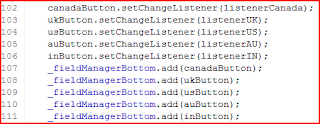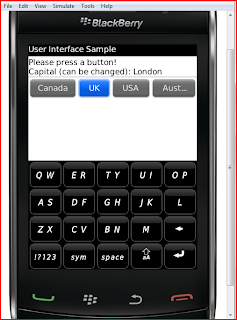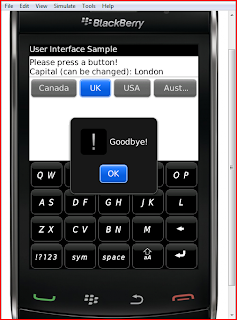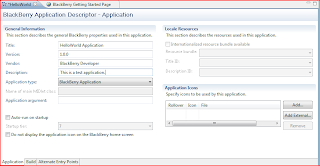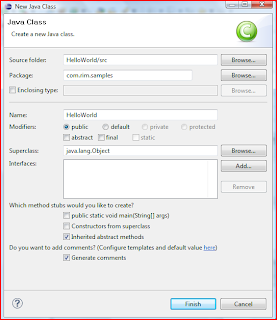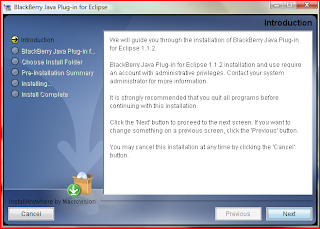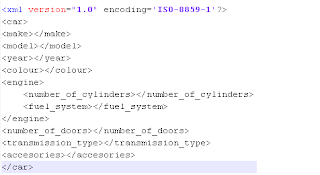Storing Persistent Data
In a blackberry application, if an objects needs to be saved and then retrieved after the blackberry device is restarted, the object needs to implement the Persistable interface. In this workshop, I will create a blackberry project that saves data and then retrieve data from the application.
Note: Sub-classes of the class implementing Persistable interface do not automatically implement the interface.
Setting up a new project:
In previous workshops, I have shown how to create a Blackberry project using Eclipse. I will create another project "Bookstore" similarly and add a class called "Bookstore.java". The class will extend UiApplication and contain some EditFields, a java.util.Vector variable and a PersistentObject variable. The class will like below.
Menu Items:
I will add menu items to Save and Get item. The Save menu will save the data that is entered and display a success message. The Get menu will retrieve the data from the saved object and populates the EditFields. The codes for the menu items are shown below.
StoreInfo class:
The StoreInfo class implements the Persistable interface. The class declares a Vector variable and some constants. Constants are used to make sure that the data is read from and saved at the same location. The class also contains methods to set and get data from the Vector variable. The code for this class is shown below.
How persistence works:
The code to how persistence works is shown below.
As can be seen, persistence occurs by calling the getPersistentObject(long id) method. This method requires us to pass a unique id that is used to identify the persistent object. The setContents(Object obj) method is used to set the contents that will be saved in the device. The commit() method is called to save the object to the Blackberry device. Data can be retrieved from the device by calling the getContents() method (it returns an Object). In Eclipse, these methods are marked with a padlock. This means that the application has to be signed before it works - however, this will fine within the simulator.
In a blackberry application, if an objects needs to be saved and then retrieved after the blackberry device is restarted, the object needs to implement the Persistable interface. In this workshop, I will create a blackberry project that saves data and then retrieve data from the application.
Note: Sub-classes of the class implementing Persistable interface do not automatically implement the interface.
Setting up a new project:
In previous workshops, I have shown how to create a Blackberry project using Eclipse. I will create another project "Bookstore" similarly and add a class called "Bookstore.java". The class will extend UiApplication and contain some EditFields, a java.util.Vector variable and a PersistentObject variable. The class will like below.
Menu Items:
I will add menu items to Save and Get item. The Save menu will save the data that is entered and display a success message. The Get menu will retrieve the data from the saved object and populates the EditFields. The codes for the menu items are shown below.
StoreInfo class:
The StoreInfo class implements the Persistable interface. The class declares a Vector variable and some constants. Constants are used to make sure that the data is read from and saved at the same location. The class also contains methods to set and get data from the Vector variable. The code for this class is shown below.
How persistence works:
The code to how persistence works is shown below.
As can be seen, persistence occurs by calling the getPersistentObject(long id) method. This method requires us to pass a unique id that is used to identify the persistent object. The setContents(Object obj) method is used to set the contents that will be saved in the device. The commit() method is called to save the object to the Blackberry device. Data can be retrieved from the device by calling the getContents() method (it returns an Object). In Eclipse, these methods are marked with a padlock. This means that the application has to be signed before it works - however, this will fine within the simulator.


























